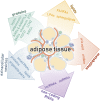Beyond adiponectin and leptin: adipose tissue-derived mediators of inter-organ communication
- PMID: 31209153
- PMCID: PMC6795086
- DOI: 10.1194/jlr.R094060
Beyond adiponectin and leptin: adipose tissue-derived mediators of inter-organ communication
Abstract
The breakthrough discoveries of leptin and adiponectin more than two decades ago led to a widespread recognition of adipose tissue as an endocrine organ. Many more adipose tissue-secreted signaling mediators (adipokines) have been identified since then, and much has been learned about how adipose tissue communicates with other organs of the body to maintain systemic homeostasis. Beyond proteins, additional factors, such as lipids, metabolites, noncoding RNAs, and extracellular vesicles (EVs), released by adipose tissue participate in this process. Here, we review the diverse signaling mediators and mechanisms adipose tissue utilizes to relay information to other organs. We discuss recently identified adipokines (proteins, lipids, and metabolites) and briefly outline the contributions of noncoding RNAs and EVs to the ever-increasing complexities of adipose tissue inter-organ communication. We conclude by reflecting on central aspects of adipokine biology, namely, the contribution of distinct adipose tissue depots and cell types to adipokine secretion, the phenomenon of adipokine resistance, and the capacity of adipose tissue to act both as a source and sink of signaling mediators.
Keywords: angiopoietin; angiopoietin-like protein; bone morphogenic protein; chemerin; endotrophin; extracellular vesicles; fatty acid esters of hydroxy fatty acids; fibroblast growth factor 21; lipocalin 2; long noncoding ribonucleic acids; lysophosphatidic acids; micro-ribonucleic acids; neuregulin 4; sphingolipids; uric acid; uridine.
Copyright © 2019 Funcke and Scherer.
Figures


References
-
- Zhang Y., Proenca R., Maffei M., Barone M., Leopold L., and Friedman J. M.. 1994. Positional cloning of the mouse obese gene and its human homologue. Nature. 372: 425–432. - PubMed
-
- Zhang F., Basinski M. B., Beals J. M., Briggs S. L., Churgay L. M., Clawson D. K., DiMarchi R. D., Furman T. C., Hale J. E., Hsiung H. M., et al. . 1997. Crystal structure of the obese protein leptin-E100. Nature. 387: 206–209. - PubMed
Publication types
MeSH terms
Substances
Grants and funding
LinkOut - more resources
Full Text Sources
Other Literature Sources

